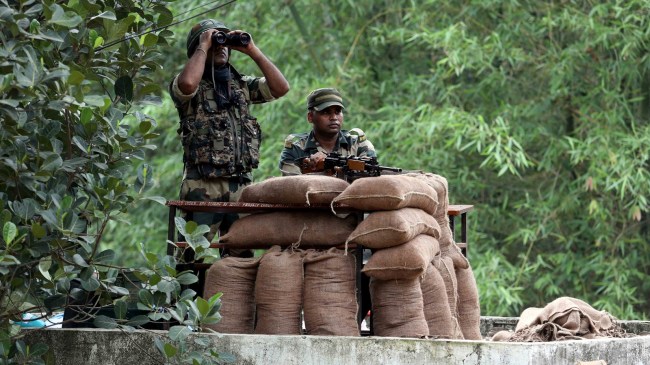Opinion Modi-Shah’s unwavering resolve against Naxalism is bearing results
Their approach, marked by a calibrated blend of security action, development outreach, and political determination, has delivered far better results than decades of vacillation
 From 126 Naxal-affected districts in 2014, the number has been pared down to just 38. (Express Archives)
From 126 Naxal-affected districts in 2014, the number has been pared down to just 38. (Express Archives) Prime Minister Narendra Modi has achieved what no Indian leader before him could — he has broken the backbone of Naxalism through an unrelenting mix of resolve, strategic clarity, and national will. That mission saw another major victory in Jharkhand recently.
Last week, the Latehar police, in a joint operation with the CRPF, under the leadership of SP Kumar Gaurav, achieved a big success. In a fierce encounter in the forests of Ichawar, Latehar district, the forces neutralised Pappu Lohra, the top commander of the Jharkhand Jan Mukti Parishad (JJMP), carrying a reward of Rs 15 lakh. Alongside him, Prabhat Ganjhu, another dreaded extremist with a Rs 5 lakh bounty, was also gunned down. This marks a decisive step forward in restoring peace in Jharkhand’s Naxal-hit regions.

This follows another historic breakthrough in Chhattisgarh, where 26 Naxals, including top Maoist leader Nambala Keshava Rao alias Basavraj, were neutralised by security forces. Basavraj — the general secretary of the banned CPI (Maoist) and one of the most elusive Maoist leaders — carried a bounty of Rs 1 crore. His elimination has dealt perhaps the biggest blow ever to the Maoist movement, shattering both its ideological leadership and operational backbone.
This is not an isolated success; it is the result of a decade-long campaign against Left-wing extremism waged under Modi’s leadership and Union Home Minister Amit Shah’s precise and forceful execution. The red corridor — once a symbol of bloodshed, state retreat, and Maoist tyranny — is now shrinking both geographically and ideologically.
When PM Modi assumed office in 2014, the Naxal threat was at a dangerous peak. Over 120 districts, spanning dense forests in Chhattisgarh, Jharkhand, Odisha, and Maharashtra, lay under the shadow of Maoist rule, enforced not by law but by guns. The state vacillated between paralysis and misplaced appeasement. Civilians paid the price with high casualties, security forces were repeatedly ambushed, and India’s internal security apparatus was stretched thin. The country’s unity and sovereignty were under severe threat.
Modi’s approach was radically different. He declared Naxalism the country’s most serious internal security threat and vowed not merely to manage but to decisively defeat it. This vision has evolved into a comprehensive, multi-pronged strategy — blending tactical precision, last-mile development, and deep political will. The results today speak volumes.
From 126 Naxal-affected districts in 2014, the number has been pared down to just 38. The most affected districts have halved from 12 to six; districts of concern dropped from nine to six, and the category of other LWE-affected districts plummeted from 17 to six. Violent incidents attributed to Maoists have fallen by over 50 per cent since 2013 — from 1,091 to 412 in 2023. Civilian deaths have declined by a staggering 86 per cent, and casualties among security personnel have reduced by 77 per cent. In 2014, 56 jawans were martyred while 63 Naxals were killed; today, these numbers have reversed, proving the state has regained control and momentum.
But the Modi-Shah doctrine is not just about guns and operations. It embodies a philosophy of replacing alienation with aspiration. Recognising that Naxalism thrives in areas of deprivation and neglect, the government launched massive development initiatives in insurgency-affected tribal regions. Thousands of kilometres of roads have been constructed, opening up villages once cut off from the rest of the country. Mobile network coverage in core LWE areas soared from under 30 per cent to over 90 per cent, connecting millions digitally for the first time.
The government’s Special Central Assistance Scheme guarantees Rs 30 crore annually to each severely affected district, ensuring targeted development reaches the grassroots. Over Rs 6,500 crore has been disbursed to enhance police capabilities, build infrastructure, and modernise security forces. Piped water, solar lighting, health centres, fortified police stations — are all now visible in areas that were once lawless and unreachable. This is governance reclaiming the lost spaces of the republic.
most read
Equally crucial has been the humane policy of surrender and rehabilitation. More than 8,000 Naxals have laid down their arms since 2014, with 1,600 surrendering in just the past 16 months. These former militants, many battle-hardened cadres, are being offered new lives through rehabilitation and skill development, further weakening the insurgency. Shah’s clear dual-track approach — embrace those who return to peace, crush those who persist in violence — has delivered far better results than decades of vacillation.
While the Modi-Shah doctrine has shown unwavering resolve, the contrast with the previous UPA regime could not be starker. The UPA government’s approach to Naxalism was marked by confusion, inconsistency, and a clear lack of political will. While the then Union Home Minister P Chidambaram famously declared in 2011 that “winning hearts is key to winning the battle against Naxalism” and ruled out the possibility of a military operation, senior Congress leaders like K Keshava Rao openly labelled Naxalism as a “socio-economic problem”, urging the Centre to “solve it instead of running away from it.” The most glaring example was the appointment of Binayak Sen — convicted on the charge of being a Maoist sympathiser — to the Planning Commission’s Steering Committee on Health during the drafting of the 12th Five Year Plan.
The results today are a testament to the government’s unwavering resolve and strategic clarity. Through a calibrated blend of security action, development outreach, and political determination, Naxalism has been taken up head on. As India marches toward a Naxal-free future by 2026, PM Modi’s doctrine stands as a model of how strong leadership can overcome even the most entrenched internal threats.
The writer is national spokesperson, BJP
Source: https://indianexpress.com/article/opinion/columns/modi-shah-naxalism-maoists-10040206/




